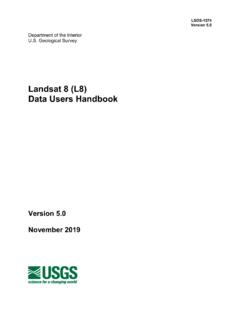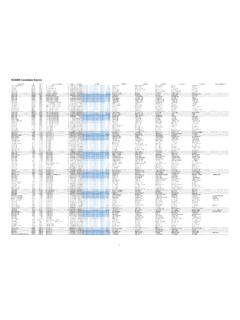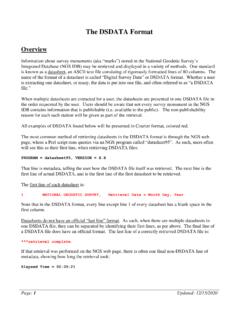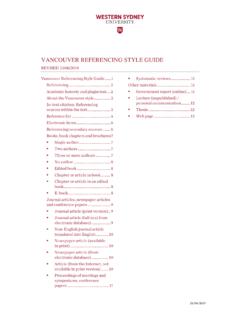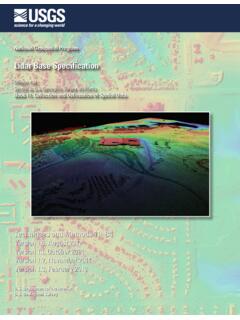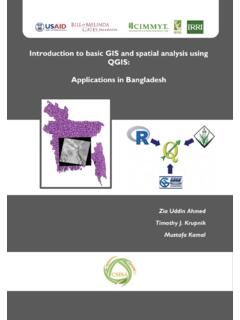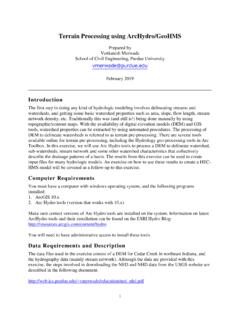Transcription of Landsat 8 Collection 2 (C2) Level 2 Science Product (L2SP ...
1 LSDS-1619 Version Department of the Interior Geological Survey Landsat 8 Collection 2 (C2) Level 2 Science Product (L2SP) Guide Version September 2020 - ii - LSDS-1619 Version Landsat 8 Collection 2 (C2) Level 2 Science Product (L2SP) Guide September 2020 Document Owner: _____ Kristi Sayler Date LSRD Project Manager Geological Survey Approved By: _____ Karen Zanter Date LSDS CCB Chair Geological Survey EROS Sioux Falls, South Dakota - iii - LSDS-1619 Version Executive Summary This document describes relevant characteristics of the Landsat 8 Collection 2 (C2) Level 2 Science Products (L2SP) to facilitate their use in the land remote sensing community. Landsat 8 L2SP contain: Surface Reflectance (SR) derived from Landsat 8 Collection 2 Level 1 Operational Land Imager (OLI) data Surface Temperature (ST) derived from Landsat 8 Collection 2 Level 1 Thermal Infrared Sensor (TIRS) data Intermediate bands used in calculation of the ST products Quality Assessment (QA) masks indicating the usefulness of the pixel data Landsat 8 SR products are created with the Land Surface Reflectance Code (LaSRC).
2 Landsat 8 ST products are created with a single channel algorithm jointly created by the Rochester Institute of Technology (RIT) and National Aeronautics and Space Administration (NASA) Jet Propulsion Laboratory (JPL). A primary characteristic of Collection 2 data is the implementation of the Sentinel 2 Global reference Image (GRI) into updated Landsat 8 OLI ground control points for improved geometric accuracy. This improves interoperability of the Landsat archive both through time and with other remotely sensed datasets. Additionally, Collection 2 includes updated global digital elevation modeling sources and calibration and validation updates. Other processing options, such as spectral indices, format conversion, spatial subset, and/or coordinate system reprojection are described in other Product guides and web pages.
3 Information about Landsat 4-7 Collection 2 Level 2 products can be found in the Landsat 4-7 Collection 2 Level 2 Science Product Guide. - iv - LSDS-1619 Version Document History Document Number Document Version Publication Date Change Number LSDS-1619 Version May 2020 CR 15400 LSDS-1619 Version September 2020 CR 20016 - v - LSDS-1619 Version Contents Executive Summary .. iii Document History .. iv Contents .. v List of Figures .. vi List of Tables .. vi Section 1 Introduction .. 1 Background .. 1 Surface Reflectance .. 1 Surface Temperature .. 3 Document Organization .. 4 Section 2 Known Issues .. 5 Surface Reflectance .. 5 Section 3 Caveats and Constraints .. 6 Surface Reflectance .. 6 Surface Temperature.
4 7 Section 4 Product Access .. 9 Section 5 Product Packaging .. 10 Section 6 Product Characteristics .. 11 Band Specifications .. 11 Radiometric Saturation Band .. 15 Aerosol QA Band .. 15 L2SP Metadata .. 17 L2SP Special Notes .. 17 Cloud and Cloud Shadow Specifications .. 18 CFMask Algorithm Known Issues .. 18 Section 7 Auxiliary Data .. 19 Surface Reflectance Auxiliary Data .. 19 Landsat 8 Ratio Map .. 19 CMGDEM .. 19 LDCMLUT .. 19 MODIS Fused Data .. 19 Surface Temperature Auxiliary Data .. 20 ASTER Emissivity Data .. 20 GOES-5 FP-IT Data .. 20 MERRA-2 Data .. 20 Section 8 Citation Information .. 21 Section 9 Acknowledgments .. 22 Section 10 User Services .. 23 Appendix A Default File Characteristics.
5 24 Appendix B Metadata Fields .. 25 - vi - LSDS-1619 Version Appendix C Acronyms .. 34 References .. 36 List of Figures Figure 1-1. Example of LaSRC Atmospheric Correction: Left, Top of Atmosphere Reflectance Image; Right, Surface Reflectance Image .. 2 Figure 1-2. Left: Surface Reflectance image (Bands 4,3,2) and Right: color-enhanced Landsat Surface Temperature for an area in Nepal, path 141 row 40 acquired on May 3, 2013. Light areas in the Surface Temperature image indicate cooler temperatures; darker areas indicate warmer temperatures.. 4 Figure 2-1. Example of speckling in Surface Reflectance bands (right), with Top of Atmosphere (TOA) Reflectance (left) shown for reference .. 5 Figure 3-1: ASTER GED Emissivity Coverage .. 8 List of Tables Table 1-1.
6 Differences between Landsat 4 7 (LEDAPS) and Landsat 8 (LaSRC) Surface Reflectance Algorithms .. 3 Table 6-1. Collection 2 (C2) Level 2 Science Products (L2SP) Band Specifications .. 12 Table 6-2. Landsat 8 Pixel Quality Assessment (QA_PIXEL) Bit Index .. 13 Table 6-3. Landsat 8 Pixel Quality Assessment (QA_PIXEL) Value Interpretations .. 14 Table 6-4. Landsat 8 Radiometric Saturation Quality Assessment (QA_RADSAT) Bit Index .. 15 Table 6-5. Landsat 8 Internal Surface Reflectance Aerosol Quality Assessment (SR_QA_AEROSOL) Bit Index .. 16 Table 6-6. Landsat 8 SR_QA_AEROSOL Values .. 16 Table 6-7. Landsat 8 SR_QA_AEROSOL Value Interpretations .. 17 Table A-1. Collection 2 Default File Characteristics .. 24 - 1 - LSDS-1619 Version Section 1 Introduction Background Landsat satellite data have been produced, archived, and distributed by the Geological Survey (USGS) since 1972.
7 Users rely upon these data for conducting historical studies of land surface change but have shouldered the burden of post-production processing to create applications-ready datasets. To alleviate this burden on the user, the USGS has initiated an effort to produce a Collection of Landsat L2SP to support land surface change studies. Landsat Collection 2 (C2) marks the second major reprocessing effort on the Landsat archive by the USGS that results in several data Product improvements that harness recent advancements in data processing, algorithm development, and data access and distribution capabilities. Surface Reflectance Landsat 8 Surface Reflectance (SR) Science Products are generated from specialized software called Land Surface Reflectance Code (LaSRC).
8 The original LaSRC algorithm was developed by Dr. Eric Vermote, National Aeronautics and Space Administration (NASA) Goddard Space Flight Center (GSFC) and was modified by staff at USGS Earth Resources Observation and Science (EROS) Center. LaSRC generates Top of Atmosphere (TOA) Reflectance and TOA Brightness Temperature (BT) using the calibration parameters from the metadata. Atmospheric correction routines are then applied to Landsat 8 TOA Reflectance data, using auxiliary input data such as water vapor, ozone, and Aerosol Optical Thickness (AOT) retrieved from Moderate Resolution Imaging Spectroradiometer (MODIS), and digital elevation derived from GTOPO5 to generate Surface Reflectance. The result is delivered as the Landsat Surface Reflectance data Product .
9 Specific details about the SR algorithm can be found in Section of the Landsat 8-9 Calibration and Validation (Cal/Val) Algorithm Description Document (ADD). - 2 - LSDS-1619 Version Figure 1-1. Example of LaSRC Atmospheric Correction: Left, Top of Atmosphere Reflectance Image; Right, Surface Reflectance Image Figure 1-1 shows a comparison of a TOA Reflectance composite (Bands 4,3,2), and a Surface Reflectance composite image of Seattle, WA, using data acquired by Landsat 8 (Path 47 Row 27) on October 14, 2013. Both images are linearly scaled from = to The LaSRC algorithm is distinctly different from the algorithm used to process Landsat 4 5 Thematic Mapper (TM) and Landsat 7 Enhanced Thematic Mapper Plus (ETM+) Level 1 (L1) products to Surface Reflectance, known as the Landsat Ecosystem Disturbance Adaptive Processing System (LEDAPS).
10 Details of these differences are described in Table 1-1. Parameter LEDAPS LaSRC Instruments Landsat 4-5 TM, Landsat 7 ETM+ Landsat 8 OLI/TIRS, Landsat 9 OLI2/TIRS2 (Available 2021) (Original) research grant NASA GSFC, MEaSUREs NASA GSFC Principal Investigator Jeff Masek, NASA Eric Vermote, NASA Global coverage Yes Yes TOA Reflectance Visible (Bands 1 5,7) Visible (Bands 1 7, 9 OLI) TOA Brightness Temperature Thermal (Band 6) Thermal (Bands 10 & 11 TIRS) SR Visible (1 5, 7) bands Visible (Bands 1 7) (OLI only) Thermal bands used in SR processing? Yes (Brightness temperature Band 6 is used in cloud estimation) No Radiative transfer model 6S Internal algorithm Thermal correction Level TOA only TOA only Thermal band units Kelvin Kelvin Pressure NCEP Grid Calculated internally based on elevation Water vapor NCEP Grid MODIS CMG - 3 - LSDS-1619 Version Parameter LEDAPS LaSRC Air temperature NCEP Grid not used DEM GTOPO5 GTOPO5 Ozone OMI/TOMS MODIS CMG Coarse resolution ozone AOT Correlation between chlorophyll absorption and bound water absorption of scene Internal Algorithm Sun angle Scene center from input metadata Scene center from input metadata View zenith angle From input metadata Hard-coded to 0 Undesirable zenith angle correction SR not processed when solar zenith angle > 76 degrees SR not processed when solar zenith angle > 76
